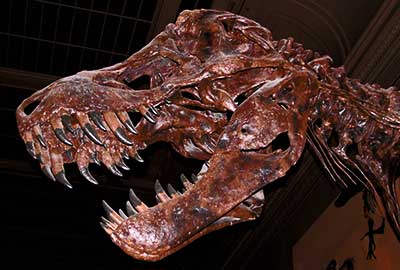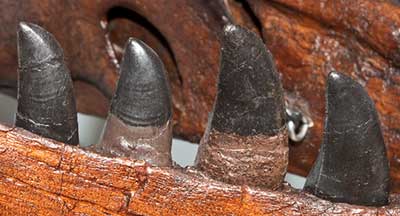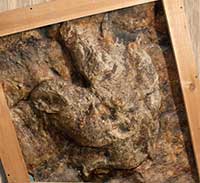Tyrannosaurus
(tie-RAN-oh-SAW-rus)
| Quick Facts | |
|---|---|
| Name Meaning: | Tyrant Lizard |
| Distribution: | Mid west U.S. and Canada (Alberta-Texas) |
| Time Period: | Late Cretaceous, 67-65 Ma |
| Length: | 40ft (12m) |
| Weight: | 7.5 tons |
| Diet: | Carnivorous |
| Habitat: | Forests, Swamps |
| Linnaean Classification | |
| Kingdom: | Animalia |
| Phylum: | Chordata |
| Class: | Sauropsida |
| Superorder: | Dinosauria |
| Order: | Saurischia |
| Suborder: | Theropoda |
| Superfamily: | Tyrannosauroidea |
| Family: | Tyrannosauridae |
| Genus: | Tyrannosaurus |
| Cladistic Classification | |
| |

History
The Tyrannosaurus rex is certainly the most widely known dinosaur in dinosaur history. It was first identified in 1905 by Henry F. Osborn and for almost a century it was the largest carnivore ever discovered. This continued until the discovery of the Spinosaurus and Giganotosaurus in the 1990's. At first it was considered as a carnivore, which carried itself upright, much as a human does, with the tail dragging behind it. The first complete Tyrannosaurus skeleton was unveiled in 1915 as standing upright. However, in the 1970's it was determined that such a posture would have caused serious strains on certain areas of the giant's body. It was then determined that the Tyrannosaurus walked horizontally with the tail held erect to balance the massive head.
 |
| Tyrannosaurus rex teath. |
Description
 |
| Tyrannosaurus rex track. |
Lifestyle
One of the longest ongoing debates among paleontologists tries to determine whether the Tyrannosaurus was an active predator or a scavenger. While its large head, long teeth, contribute to the idea that it was not just a scavenger, there are many evidences that it may have been. Its legs are thick and strong for traveling long distances as a scavenger would and also has small eyes and hands, and large olfactory lobes. It may have performed both functions as a predator and scavenger. The arms may have had several functions. The arms had many locations for muscle attachment making them extremely strong despite their size. They may have been used for lifting itself, for mating, or for holding struggling prey.Popular Culture
The Tyrannosaurus rex is the most popular dinosaur to appear in modern culture. Its success may be due partially to the New York Times which stated in 1905 that the Tyrannosaurus was "the most formidable fighting animal of which there is any record whatever," the "king of all kings in the domain of animal life," and other such statements. It has made appearances in countless film and television productions the most influential being 1933's King Kong and Steven Spielberg's Jurassic Park and The Lost World.
ScienceViews Writer: Jason Hamilton.
Copyright © 2005-2010 Calvin & Rosanna Hamilton. All rights reserved.